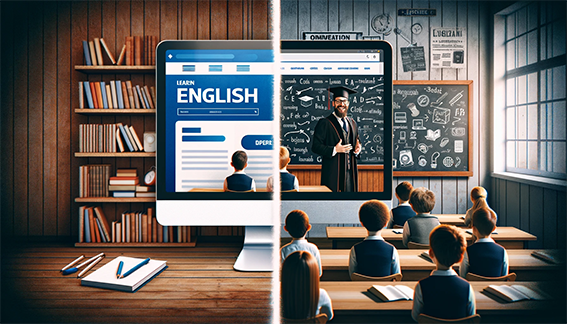Phil Collins From EssayService Compares Online Learning With Traditional Education

What seems to be an ongoing debate was settled long back when the world unanimously shifted to online learning in no time, particularly for English lessons. Yet many argue that the traditional approach has no match. Yes, some people can’t study or work from home. But online modes of education have proven benefits that in-class learning simply can’t offer.
Hence, whether or not online learning is better than traditional learning largely depends on the individual’s needs. However, a large segment of learners prefers a flexible learning environment that only online modes of education can provide.
Below, we will compare the two learning modes in more detail. Let’s dive in!
Online Learning vs. Traditional Education
Flexibility
The traditional classroom setup was never meant to be flexible, so many school-goers would have to compromise on their studies and other commitments. Learners today take up more than one course, attend extracurricular classes, and even work part-time for hands-on training. Online learning gives them the freedom to follow their own schedule, study at their own pace, and not miss out on any additional pursuits.
Some institutions offer online lectures of the lessons taught in physical classrooms, which enables students to access them anytime, anywhere. Online recordings of lectures also aid students who have slow grasping power to study and comprehend lessons in as much time as it takes.
Versatility
Online education is versatile in terms of teaching techniques, assessments, and student engagement. Traditional classrooms, where one teacher would address a class of 30-50 students, generally fail to attain active participation. The teacher cannot address every student’s query and employ various teaching techniques within a limited time.
However, online education enables teachers to use different teaching methods to deliver lessons efficiently. For example, they can record lectures separately if they wish to conduct an interactive learning session during the class. They can also review more assignments and address student queries frequently. Virtual classrooms also help students feel more comfortable, allowing them to open up, which encourages more active participation.
Affordability
A quick calculation shows how much a student can save by opting for online learning. Contrary to physical education, students don’t have to spend on transport, dorm room, or other living costs. Besides, since online courses are flexible, you can manage to work part-time and study simultaneously, aiding your expenses with your side income. Hence, online education turns out to be more inexpensive than traditional.
Accessibility
To access an online lecture, you only need a laptop, a computer, or a phone, a stable internet connection, and willpower. But traditional setup expects you to mold your way around a set system that doesn’t consider anybody’s limitations and inabilities. However, online modes of education break this norm and offer easy accessibility to everyone willing to pursue a course.
Whether you live in a far-off place and can’t move to or travel to the location of your school, or you are unable to match your schedule with the school’s, you can access courses and study on your terms. Many renowned schools, such as Harvard, have started offering non-credit courses for free for those who only want to upskill.
Many other eLearning platforms offer certification and degree courses at affordable prices for students with financial restrictions. This way, online education makes learning possible and accessible for everyone.
Ease of Feedback
Assessing an online test is easier than evaluating piles of answer sheets by hand. There are numerous tools available that allow you to check answers in one go. Hence, with online lessons, teachers have gotten a way to closely monitor every student’s progress and provide individual feedback more frequently.
With online assessments, teachers can simply mark their feedback in the answer sheets directly and allow students to reach out if they have any questions. These assessments are also helpful in identifying common problems learners have, which can be addressed separately to enhance the overall learning experience.
Accountability
Most students are passive audiences in a traditional classroom setup where they don’t feel obligated to engage in classrooms and take up the responsibility to study what they need to learn. Most students don’t even revise the chapter after heading home or research a topic before it is taught in class.
However, online learning means no supervision, at least nothing like in a physical classroom. Hence, if you want to master a subject, you have to be self-reliable and take up the responsibility to attend online lectures, complete assignments on time, read additional resources, and actively participate in classroom activities.
Online learning shifts the accountability to students from teachers and makes them more self-driven. They also learn to manage time and balance their schedule, subtly developing soft skills required in later stages of life.
Digital Proficiency
Traditional education can only teach enough to make you able to research topics and find solutions. However, with an online learning setup, you become competent in video conferencing, professionalism over messages, email skills, and collaboration, all along with your regular lessons. You also understand how to balance your digital usage and how much information is worth sharing. In short, it prepares you for your future and career, adding to your professional skills.
Wrapping Up
With no hard feelings for in-class learning, online learning is the present and the future of education. There was a time when traditional learning setups were apt for that generation. However, with technological advancements and changing aspects of lifestyle and learning, virtual modes are preferable education delivery methods today.













